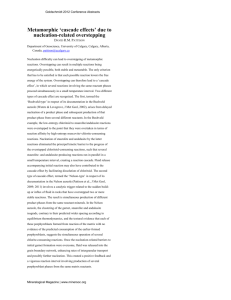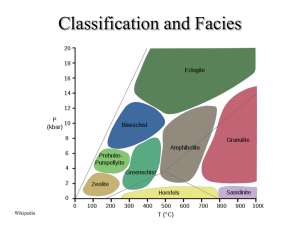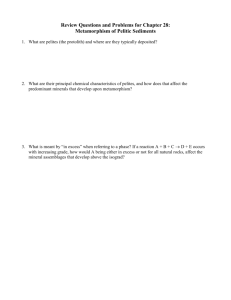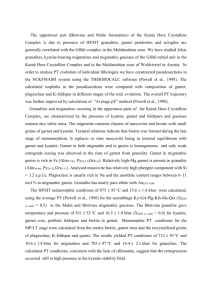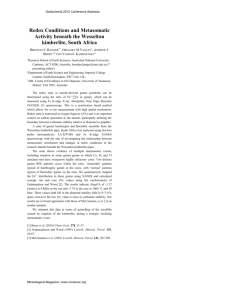Magnesian staurolite in garnet-corundum rocks and eclogite
advertisement
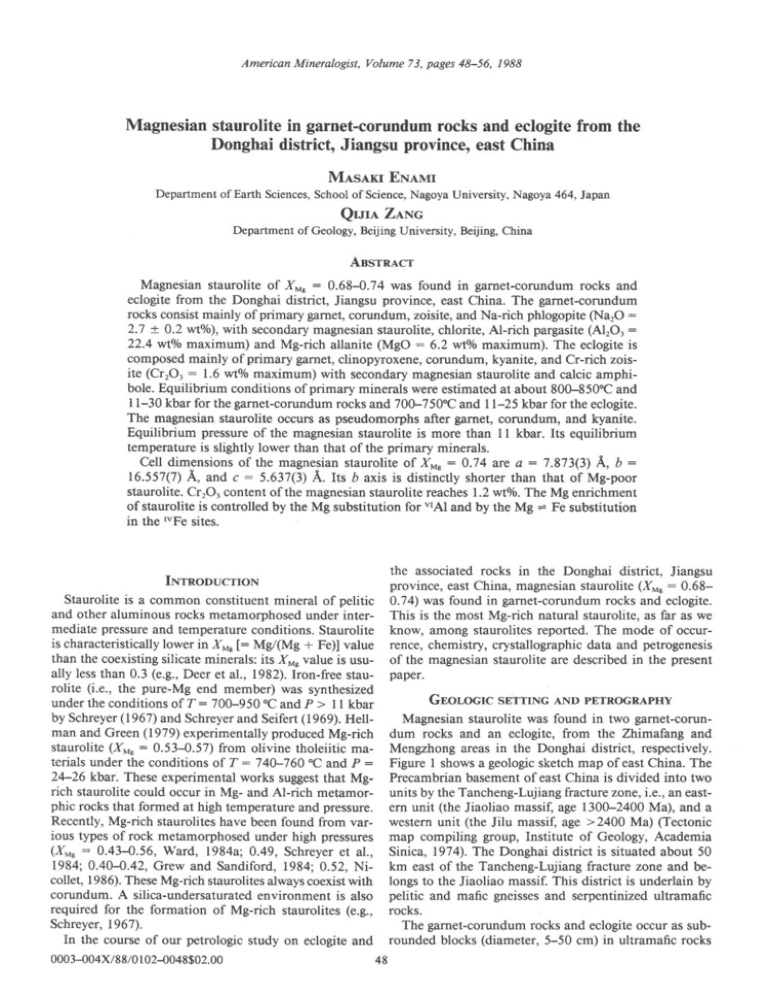
American Mineralogist, Volume 73, pages48-56, 1988 Magnesianstaurolite in garnet-corundumrocks and eclogite from the Donghai districtoJiangsu province,east China Mlsaxr ENavrr Department ofEarth Sciences,School ofScience, Nagoya University, Nagoya 464, Japan Qr.ru. ZlNc Department of Geology, Beijing University, Beijing, China Ansrru,cr Magnesian staurolite of X*, : 0.68-0.74 was found in garnet-corundum rocks and eclogite from the Donghai district, Jiangsu province, east China. The garnet-corundum rocks consistmainly of primary garnet,corundum, zoisite, and Na-rich phlogopite(NarO : 2.7 + 0.2 wto/o),with secondarymagresian staurolite, chlorite, Al-rich pargasite(AlrOr: 22.4 wto/omaximum) and Mg-rich allanite (MgO : 6.2 wto/omaximum). The eclogite is composedmainly of primary garnet, clinopyroxene, corundum, kyanite, and Cr-rich zoisite (CrrO3 : 1.6 wto/omaximum) with secondarymagnesianstaurolite and calcic amphibole. Equilibrium conditions of primary minerals were estimatedat about 800-850'C and I 1-30 kbar for the garnet-corundumrocks and 700-750t and I l-25 kbar for the eclogite. The magnesianstaurolite occurs as pseudomorphsafter garnet, corundum, and kyanite. Equilibrium pressureof the magnesianstaurolite is more than 1l kbar. Its equilibrium temperatureis slightly lower than that of the primary minerals. Cell dimensionsof the magnesianstauroliteof XM,:0.74 are a:7.873(3) A, b: 16.557(7)A, and c: 5.637(3)A. Its b axis is distinitly shorrer than that of Mg-poor staurolite. CrrO, content of the magnesianstaurolite reaches| .2 wto/o.The Mg enrichment of staurolite is controlled by the Mg substitution for vIAl and by the Mg + Fe substitution in the IvFe sites. the associated rocks in the Donghai district, Jiangsu province, east China, magnesianstaurolite (X., : 0.68Staurolite is a common constituent mineral of pelitic 0.74) was found in garnet-corundum rocks and eclogite. and other aluminous rocks metamorphosedunder inter- This is the most Mg-rich natural staurolite, as far as we mediate pressureand temperature conditions. Staurolite know, among staurolites reported. The mode of occuris characteristicallylower in X". [: Mg/(Mg + Fe)] value rence, chemistry, crystallographic data and petrogenesis than the coexisting silicate minerals: its Xr, value is usu- of the magnesianstaurolite are described in the present ally lessthan 0.3 (e.g.,Deer et al., 1982).Iron-freestau- paper. rolite (i.e., the pure-Mg end member) was synthesized Gnolocrc sETTTNGAND PETRoGRAPHY under the conditionsof i": 700-950 "C and P > I I kbar by Schreyer(1967)and Schreyerand Seifert(1969).HellMagnesian staurolite was found in two garnet-corunman and Green (1979) experimentally produced Mg-rich dum rocks and an eclogite, from the Zhimafang and staurolite(X-u: 0.53-0.57) from olivine tholeiitic ma- Mengzhong areas in the Donghai district, respectively. terials under the conditions of Z: 740-760 "C and P : Figure I showsa geologicsketch map of east China. The 24-26 kbar. These experimental works suggestthat Mg- Precambrian basementof east China is divided into two rich staurolite could occur in Mg- and Al-rich metamor- units by the Tancheng-Lujiangfracture zone, i.e., an eastphic rocks that formed at high temperatureand pressure. ern unit (the Jiaoliao massif, age 1300-2400 Ma), and a Recently, Mg-rich stauroliteshave been found from var- western unit (the Jilu massif, age >2400 Ma) (Tectonic ious types of rock metamorphosedunder high pressures map compiling group, Institute of Geology, Academia (X-" : 0.43-0.56, Ward, 1984a; 0.49, Schreyeret al., Sinica, 1974). The Donghai district is situated about 50 1984; 0.40-0.42, Grew and Sandiford, 1984; 0.52, Ni- km east of the Tancheng-Lujiang fracture zone and becollet, 1986).TheseMg-rich staurolitesalwayscoexistwith longs to the Jiaoliao massif. This district is underlain by corundum. A silica-undersaturatedenvironment is also pelitic and mafic gneissesand serpentinized ultramafic required for the formation of Mg-rich staurolites (e.g., rocks. Schreyer,1967). The garnet-corundum rocks and eclogite occur as subIn the course of our petrologic study on eclogite and rounded blocks (diameter. 5-50 cm) in ultramafic rocks INrnooucrroN 0003-004x/88/01024048$02.00 48 49 ENAMI AND ZANG: MAGNESIAN STAUROLITE stauroliteof magnesian compositions Tneue1. Bulkchemical bearingrocks TM-02 rs-03f wr% sio, Tio, Alro3 CrrO" FerO. FeO MnO Mgo Nio CaO Na.O K.o l-T-l ximuertitel.-71 routt l---l M"soroi.-Cenozoic PrO, H,O(+) H,O(-) Total 34.26 0.02 34.87 0.31 0.58 4.14 0.18 13.40 n.d. 10.90 0.15 0.05 0.33 0.32 0.12 99.63 47.0 0.58 14.1 0.79 7 76' o.12 14.3 0.05 13.5 0.81 0.o2 0.01 Or Ab An Di 0.1 6.9 34.8 25.6 Hy 13.5 ol 14.3 Mt Cm llm Ap 99.0 En Fs Wo En Fs Fo Fa 9.5 2.7 13.4 10.5 3.0 10-g 3.4 1.6 1.2 1.1 0.0 99.1 Note.'Normativecomposition of TM-02 was calculatedon the basis of ratio of 0.15. Fe3+lFe2+ . Total Fe as FeO. | [T[I[TTIr-ot" Proterozoic Poloeozoic t Analyzed by ShiguangWang. Proterozoic -o^,,-^ | Io,.no"on-Eorty Fig. 1. Geologicsketchmap of eastChina(simplifiedfrom ue (1.0) and low FerO, + FeO content (4.7 wto/o)and is Research Instituteof Geology,ChineseAcademyof Geological similar to that of some diaspore bauxites (e.g., Valeton, Sciences, 1982).TLFZ: Tancheng-Lujiang fracturezone. 1972).This rock is alsoenrichedin MgO and CaO. These components may have been derived from dolomite or intruding the Precambrianpelitic gneisses.The ultramaf- dolomitic limestones, which are usually associatedwith ic rocks in the Zhimafang area are serpentinizedphlog- bauxites. The garnet-corundum rocks are considered to opite-bearinggarnetlherzolite. Equilibrium conditions of be metamorphosedmixtures of bauxitesand Mg-rich qarthe garnetlherzoliteare estimatedat about f: 750-850 bonate rocks, on the basis ofthe occurrenceofdiaspore 'C and P : 20-30 kbar (Zang et a1.,in prep.). The ultra- and carbonate inclusions in the corundum crystals and mafic rocks in the Mengzhong area are completely ser- the bulk chemistry of the garnet-corundum rock. pentinized. Bulk chemical analyses of the magnesian Mengzhong sample staurolite-bearingrocks are given in Table l. The Mengzhong sample (TM-02) is massive and conZhimafang sarnples sists of a clinopyroxene-rich $een part and garnet-rich The Zhimafang samples (TS-03 and TS-04) are com- brown part. The sample contains garnet, clinopyroxene, posedof a corundum-rich pink part and garnet-richwhite and subordinate amounts of corundum, kyanite, zoisite, part. The samples contain garnet and corundum with dolomite, rutile, and apatite as primary minerals' Secsubordinateamounts of Na-rich phlogopite,zoisite, pent- ondary minerals are magnesianstaurolite, calcic amphilandite, and apatite as primary minerals. Aggregatesof bole, clinozoisite, and chlorite. fine-graineddiaspore,margarite,dolomite, and calcite (all Garnet occursusually as euhedral or subhedralcrystals <0.03 mm in size)were observedas inclusions in corun- 0. l-0.5 mm in diameter. Large garnet crystals l-2 cm in dum crystals. Secondaryminerals are magnesianstauro- diameter are sometimesobserved.The garnetcrystalsare lite, Al-rich pargasite,chlorite, clinozoisite, Mg-rich al- usually replaced by calcic amphibole, chlorite, and clinozoisite around crystal rims and along fractures. Clilanite, and heazlewoodite(Ni.Sr). Both garnet and corundum occur as anhedral crystals nopyroxeneoccursas rounded and subhedralcrystals0.10.1-2.0 mm in size.They are usually surroundedby ag- 0.5 mm in sizein the matrix and as fine inclusions smallgregatesof magnesianstaurolite and chlorite. Garnet is er than 0.05 mm in size in the garnet crystals.Corundum partly replaced by Al-rich pargasite and clinozoisite is smaller than 0.03 mm in size and is rimmed by chloaround the crystal rim and along fractures. Phlogopite rite. Kyanite forms anhedral crystals smaller than 0'02 showsa subhedraland tabular form and is partly replaced mm in size and is replaced by magnesianstaurolite and by chlorite. Magnesian staurolite constitutes acicular and/ calcic amphibole. Zoisite shows prismatic forms 0'l-0.3 or prismatic crystals and forms pseudomorphsafter gar- mm in length and occurs usually as inclusions in garnet. net and corundum with chlorite (Fig. 2). Some zoisite crystals contain fine-grained garnet inclugarnet-corundum (TSThe bulk chemistry of the rock sions smaller than 0.03 mm in size.Magnesianstaurolite 03) is characterizedby an extremely high AlrO./SiO, val- forms anhedral crystalssmaller than 0.02 mm in size and 50 ENAMI AND ZANG: MAGNESIAN STAUROLITE Magnesian staurolite Fig.2. Backscattered-electron imageof magnesian staurolite (sampleTS-04).Scalebar indicates200 and otherconstituents pm. Abbreviationsfor minerals:St, magnesian staurolite;Grt, garnet;Crn, corundum;Chl, chlorite. occurs as pseudomorphsafter kyanite. Magnesian staurolite crystalsare partly surrounded by calcic amphibole. The garnet + clinopyroxene + corundum assemblage of the Mengzhong eclogite suggestsequilibrium conditions of T:100-750 "C and P : ll-25 kbar for the primary stage(Enami et al., 1986).Its bulk and mineral compositions are similar to those of eclogitexenoliths in kimberlites (Tables I and 3; also cf. Dawson, 1980).These data suggestthat the Mengzhong eclogite was generated from the lower crust or upper mantle. MrNpn.q.Locy oF MAGNESTANsTAURoLITE ANL, ASSOCIATED MINERALS Chemistry. HrO content of staurolite is variable and cannot be associatedwith a fixed stoichiometry (e.g.,Juurinen, 1956;Lonker, 1983;Holdawayet al., 1986a).Li is sometimesconcentratedin staurolite(Hietanen,1969; Grew and Sandiford,1984;Holdaway et al., 1986b; Dutrow et a1.,1986).HrO and LirO contentscannot be estimated by err"re analysis, and so the chemical formula of the magnesianstaurolite was calculatedon the basis of Si + Al * Cr: 25.53 as recommendedby Holdaway et al. (1986b).Y,O,,ZnO, CoO, CaO,Na,O, and KrO contents of the magnesianstaurolite are below the detection limits, i.e.,lessthan 0.02wto/ofor VrO, and lessthan 0.01 wto/ofor the other elements. The magnesianstaurolite is faintly yellow in thin section and chemically homogeneous.X., values l: N4g/ (Mg + Fe)l of the magnesianstaurolite are 0.74 + 0.01 and 0.69 + 0.01 in the Zhimafangand Mengzhongsamples, respectively.Average Si content per formula unit is 7.92 for the Zhimafang samples and 7.14 for the Mengzhong sample.Grew and Sandiford (1984) pointed out that lower Si content is characteristicof Mg-rich staurolenvironments.Although the ite from silica-undersaturated present samples contain corundum, the Si contents of these magnesianstaurolites are higher than the Si contents of Mg-rich staurolite from other corundum-bearing samples(e.e.,7.43-7.68; Ward, 1984a).The magnesian staurolite here occurs as pseudomorphsafter corundum and/or kyanite, and so the relatively high Si contents are probably due to disequilibrium with the associatedaluminous minerals. CrrO, contents of the magnesianstaurolite are up to 0.70 and 1.17wt0/ofor the Zhimafangand Mengzhongsamples,respectively. Figure 3 explores the variation of cation contents in the staurolite monolayer, except for Al (FM content : Fe * Mn + Mg + Zn -l Co + Ni + Li + Ti), for staurolites reported in the literature. Figure 3 clearly shows that the FM content ofstaurolite increaseswith increase FM content of Mg-rich in I", value (: M/FM.The staurolites(Ir, > 0.4) is higherthan 4.0, and its average is 4.6. The FM content of Mg-poor staurolites (I., = 0.2) is mostly lower than 4.2, and its averageis 3.9. Two Mg-poor stauroliteswith -FM > 4.6 werereportedby Griffen and Ribbe (1973)(specimens4 and l0), and the latter has a high ZnO content of 6.86 wt0/0.Staurolites with Y-": 0.24.4 have compositionsintermediatebetween the above two groups (averageFM content is 4.2), except for the unusuallyZn-enriched staurolitesvithZnO :7 .44 and 6.73 wto/oreported by Juurinen (1956) and Miyake (1985),respectively.The compositionalvariation seenin Figure 3 may have some uncertainities becauseof the absenceof HrO and/or LirO data in most analyses.Thirty complete analysesof staurolite,l including HrO and LirO, by Holdaway et al. (1986b),however,also show that the Chemical analyseswere performed with a lBor- electron-probe microanalyzer (nrua) JCxA-233.Accelerating voltage, specimencurrent, and beam diameter were kept at 15 kV, 1.2 x 10 8 A and 3 pcm,respectively.Chemical compositions of the magnesianstaurolite and other constituent minerals are given in Tables 2 and 3, respective' Excludingoneanalysis(specimen 6-3),believedto be inacly. curateowingto variabilityin Li content(Dutrowet al., 1986). 5l ENAMI AND ZANG: MAGNESIAN STAUROLITE TnaLe2. Chemicalcompositionsof magnesianstaurolites Mengzhong Zhimafang TM-02 TS-03 c-1t sio, Tio, Atr03 Cr,O. FeOMnO Mgo Nio CaO Naro KrO Total Si AI Ti Cr Fe2** Mn Mg Ni Ca Na K X"nf n:20I C-27 29.8(0.3) 29.8 29.5 0.00 0.00 0.00 s5.9(0.4) 55.8 56.2 0.s3(0.08) 0.53 0.57 4.69(0.21) 4.70 4.60 0.07(0.03) 0 09 0.10 7.38(0.07) 7.37 7.35 0.16(0 05) 0.14 0 . 11 0.00 0.00 0.00 0.00 0.00 0.00 000 0.00 0.00 98.5 98.4 98.4 (si + Al + Formulae 7.917 7.927 7.830 17.502 17.492 17.580 0.000 0.000 0 000 0.111 0 11 1 0,120 1.042 1.045 1.021 0.016 0.020 0.022 2.922 2.923 2.908 0.034 0.030 0.023 0 000 0.000 0.000 0.000 0.000 0.000 0.000 0.000 0.000 o.74 0.74 0.74 299(0.4) 0.00 56.1(0.4) 0.54(0.09) 4.76(0.19) 0.03(0.03) 7.50(0.15) 0.16(0.03) 0.00 0.00 0.00 99.0 cr : 25.53) 7.915 17.502 0.000 0.113 1.054 0.007 2.960 0.034 0.000 0.000 0.000 0.74 n:7I crf 28.1 28.s(0.2) 0.33 0.25(0.06) 54.4 s5.0(0.s) 0.83(0.21) 1.17 5.92(0.10) 6.09 0.00 0.00 7.36(0.11) 7.33 0.00 0.00 0.00 0.00 0.00 0.00 0.00 0.00 97.9 97.4 7.743 17609 0.051 0 178 1.345 0.000 2.981 0.000 0.000 0.000 0.000 0.69 7.703 17.574 0.068 0.254 1.396 0.000 2.995 0.000 0.000 0.000 0.000 0.68 Nofe.'Values in Darenthesesare the standard deviations. . Total Fe as FeO. t n, number of analyticalpoints; C-1 and C-2, crystals 1 and 2 for the X-ray analysis,respectively; Cr. most Cr-richcomoosition. + XM,: Mg/(Mg + Fe). FM content increaseswith increasing Ir, value in staurolite: averageFM content of nine stauroliteswith yMs> 0.2 is 4.5 and that of three stauroliteswith fM8 = 0.1 is 3.8. High FM csntent of some staurolitescan be possibly explained by substitution of vIAl by Fe3*, which would be seenas part of the FM components (Holdaway et al., 1986b).Most of Mg-rich stauroliteswith fMs > 0.4, however,coexistwith zoisiteor Fe3+-poorclinozoisite(FerO, : 2.33-4.2 wto/o)and probably have little Fe3*.Staurolite of high Yr" tends to be lower in "tAl content and vice versa:AveragevIAl contentsare 17.3 and 11.6 for staurolites with Y-, > 0.2 and fMg < 0. 1, respectively(Holdaway et al., 1986b).Thus the high FM content of Mgrich staurolite suggeststhe preferential Mg substitution for "IAl. Alternative explanationsfor the "'Al = Mg substitution are 2vIAl -= 3 Mg (seeWard, 1984a)or vrAl + Mg+H. Lonker (1983) showed the negative correlation between vIAl and (Fe + Mg) + OH contents.This negative correlation implies that the second substitution scheme better explains Mg enrichment in staurolite. The present magnesianstaurolite has lower FM (4.0-4.4) and lower Fe (l.l-1.3) concentrationsthan those of other Mg-rich staurolites. This fact suggeststhat the Fe = Mg substitution in theI"Fe sitesalso affectsthe high Mg contentof the magnesianstaurolite concerned.The Mg substitution in the IvFe sites is attributed to the extremely high X., values of host rocks (0.84 for TS-03 and 0.77 for TM02). X-ray data. The magnesianstaurolite was examined on a Rigaku RAD-?BX-ray microdiffractometer with position-sensitive proportional counter (esnc,/vrocsystem), using V-filtered CrKa radiation ()\:2.29092 A, 40 kV, 200 mA). X-ray diffraction data were obtained from the two selectedareas of about 30 um in diameter for two crystalsin a thin section.Averagechemical compositions ofthe selectedareasobtained by errue analysesare shown in Table 2. The X-ray diffraction data are summarized in Table 4. Peakswere indexed with respectto Schreyerand Seifert (1969)and Borg and Smith (1969).Diffractionswith d > 6.6 A could not be observed, since 2d of the microdiffractometer rangedfrom 20" to 140" in the presentstudy. Preliminary X-ray powder-difraction analysis of a mixture of the magnesianstaurolite and gamet crystals showed a weak peak at d : 8.34 A, correspondingto the 020 reflection of the magnesian staurolite. Observed peaks and their intensitiesare different betweenthe two selected areas,becauseof the limited oscillation anglesaround 4 and X axesof the microdiffractometer. Peak positions of the presentstudy correspondwell to those ofFe-free staurolite svnthesizedbv Schreverand Seifert (196q. An or- 52 ENAMI AND ZANG: MAGNESIAN STAUROLITE ,' SSPBSbSPS$tt ilqqqqqCqqqqq e o,iorocoNoor ' Q d out?d 9- -e- d?dud?e qc jqc r, l9qol ? o o l O O N (^J d IO, o C o oicioociocj-oo o o E f c o @ S;: ov o N <'rFFFNtoooooo rr ooo@ oo F oo oo oo o6 o6 oo o oo O ci - d o o octo q ) ( o o 6i o o o o o o t oos)@(90000001N o ctq) o o cj o d o o cjld oto ct o o N o c Y(J ob<9*<,ooot -a OOOFTOONOOOOIO, F o q - ctct d ci o o o@to J (oNooL-ooooo iTl O o@ oN oo OO O FOeOFOo O OaO O O ci - ct ct cj o o o ctlct :< cict ct o c o I F -essoe OOObNO--OOOI$ * d ct at d - d rtct oFNIO i o Nor ?r r 8O FRO O8OPO 6SO 8 53598o @rOO 6i cjlg O oi d ci d cici ci o o o o o o x IF 6o qJ F d) O --qolaolaq6!qqlt Tde",iSdpdgddlE o c Sooo@N$@oooo OOO@IO=If)OO)OO(O llqqq':\qaq\qCq oci-ctooo;cicjooo 90, o -dq <E OE '=g t@ oll S-oo@N+oNooo Ns)od)@--o@oo(o ilqqqg\qqqqcqq o d - ct ci ct ct J ci ci o o o (? (9 q) ( | q q q q o t 9 9 o o oot <s f o o t d d d j d d d dl8 S F N ,- 60o) * o a E- F FFO O @ c J c g= b 6 ox .eF E 5 oc * ; (o f.9 c? E6 (0 ' EE E ='i ooo@sooo $t\O(JFOOO@ qoqol-qqqq ooocoooooo :9 &qgq gs g $Ol a?qsa?a?qrq':aqlNONOtr)OrOc)(ONOIO t N F cdcici P ' t oo@r oo i ln q q oooo RdNdoididdd<jlb 8< ll 6i Ai o EO o u o At@o ooool oo€cJ(tooNoooto -c ro o o 0 ESHgE cEEEebc = O: oi =q co o -SoqEBRe-8813 $dp.-ci@tr=ddlg :9 lO il oooo \f(9@NNF$O dr@OFOSfTr)OO) Od)OFOo(oOO OOOOOFOOO (g o E 6o o oo ooN ooo o, ; OooAlOOool FNaaOOOOIF <ooNooioo-oooo ,I O, O @oFooooo6o OOOOOOOOOO ; cr d - ci d ci dd cici o d d ci cilE d ci ci c; ^a= o o Eoll q qeq a ?rg' .r .q*q n qoq l c o o r o o o o 6 o 9. -lE $ R S=R8P8338:88. @ee.oo a-?eC q n C q g q \ ' . C l n@ o r o o o o o I o ol3 3 3o NR=SgBBSgEgS t:qo?qqCqqCo?qq O$ N o o o o o o F o o ilqo?gqacqccqqq o a JF o o o o r o F o o o 6 E o C) a (u F @@o ro@Fr e E o F9@NNoo€o@Nto oodci-d+oc;oiNld u to ss$$F E9es3eF () - o F N lO Ec E? i.l ;iH U :- oi =€ dz NeUcKBBgBBSEilalqqqco?cq\qo? ObOOOOO$OOO-o r . i +., z; o o o_ ; E E o)y ,.1: i b < i : ( 5 P 5 9 2 8 5 - x s P * 3a 53 ENAMI AND ZANG: MAGNESIAN STAUROLITE TneLe4. X-ray data of magnesianstaurolite in TS-03 Crystal2 Crystal 1 Ulo 4.53 4.43 3.549 <5 4.45 20 3.527 3.225 ZJ 3.007 95 2.618 2.542 2.387 20 100 40 3.048 3.002 2.846 2.683 15 55 15 65 2 542 55 z Jbb Ulo 10 100 2.351 2.289 Fig. 3. Variations of FM (: Fe * Mn + Mg + Zn + Co + Ni + Li + Ti) content of staurolites.Solid trianglesindicate aveftge FM contents.Data are from Asami and Hoshino (1980), Asami et al. (1982),Ashworth (1975),Baltatzis(1979),CEchet al. ( I 98 1),Enami and Zang(this paper),Foster( 1977),Fox ( I 97 l), Gibson (1978),Green(l963), Grew and Sandiford(1984),Griffen and Ribbe (1973),Guidotti (1970),Hietanen(1969),Hiroi (1983),Hollister (1970),Hollister and Bence(1967),Hounslow andMoore (1967),Hudson(1980),Juurinen(1956),Kwak (1974), Lonker(1983),Miyake (l 985),Pigage(l 976),Schreyerand Chinner (1966),Schreyeret al. (1984),Smith (1968),Tak6uchiet al. (1972),von Knorring et al. (1979),and Ward (1984a,1984b). 40 2 257 2.099 2 069 2.054 2.003 30 30 <5 10 <5 1.776 1.765 1.706 c <5 10 1 570 't 542 5 10 1 514 70 1.474 1.447 1.429 15 15 10 1.378 1.371 1.312 5 60 30 2.097 2.069 1.857 10 1 763 <5 1.660 1.600 10 15 1.542 1 538 JC 30 1511 1.473 1.446 5 30 1.423 J 1. 3 1 0 1.296 5 TC 3 4.52 4.42 3.555 3.526 3.227 3.052 3.007 2.853 2.684 2.620 2.545 2.392 2.370 2.355 2.292 2.260 2.102 2.070 2.O57 2.005 1.858 1.778 1.766 1.707 1.661 1.600 1.569 1.541 1.536 1.514 1.512 't.473 1.446 1.428 1.422 1.380 1.370 130 111 220 131 201 150 221 240 151 112 241 132 330 311 202 260 171 080 350 -242 401 440 172 191 223 153 243 461 282 530 192 210 173 0102 550 0120 512 1 <5 1.279 1.273 <5 <5 1.264 1.255 1.239 10 c 1.267 J <5 1.239 1.221 10 10 thorhombic cell was assumed,and unit-cell dimensions of garnet end members are Prp54sAlm,ooGrsrrrSpsor, calculated on the basis of 30 reflection data with 44. < PrprrrAlm,ooGrsro oSpso r, and PrprorAlmrr rGrsr'Spso, 20 < 120" (excluding 0k0 reflections)are as follows: a : for TS-03, TS-04, and TM-02, respectively(abbreviations 7.873(3)A, b : r6.5s7(7)A, and c: 5.637(3)A. rhe a after Kretz, 1983).The CrrO, content of TM-02 garnet and c axes are similar to those of staurolites in the literreaches2.9 wto/oin the crystal core. The clinopyroxene is ature(a : 7.850-7.891A and c: 5.635-5.667A). crifpale green in hand specimen,considering its substantial fen et al. (1982) showedthat the b axis ofstaurolite de- CrrO. content (0.63 wto/omaximum), and is sodian augite creasessystematicallywith decreasingmean ionic radius (NarO : 2.0 + 0.3 wto/o, X*u:0.94) of Esseneand Fyfe (MIR) of cations in the monolayer. The D axis of the (1967). The amphibole varies in composition from flake magnesianstaurolite (TS-03) lies close to the regression to flake. In the TM-02, the amphibole replacinggarnet is line of that againstthe MIR value (Fig. 4). magnesiohornblendewith AlrO, : 12.0 + 2.1 wto/oand, that replacing the magnesian staurolite is tschermakite Garnetoclinopyroxene,and calcic amphibole with maximum AlrO, of 18.8 wt0/0,according to the noThe garnet is mostly homogeneousand belongs to a menclature of Leake (1978). The amphibole in the Zhigrossular-richpyrope-almandine serieswith very low MnO mafangsamplesis Al-rich pargasite,and its AlrO3 content content(lessthan 0.3 wto/o).Averagecompositionsin terms is up to 22.4 wto/o. 54 ENAMI AND ZANG: MAGNESIAN STAUROLITE Fig. 4. Relationship between mean ionic radius (MIR) of cations in the monolayer and b axis of staurolite. Regressionline plotted was calculatedusing ten data of synthetic staurolites.Ionic radii were taken from Griffen ( I 98 1) for Zn and from Shannon (1976)for the other elements;r: correlationcoefficient.Dataarc from C6ch et al. (1981),Enami and Zang (this study),Griffen and Ribbe (l 973),Juurinen(1956),Miyake (1985),Schreyerand Chinner(1966),Smith (1968),Tak6uchietal. (1972),von Knorring et aI.(1979),and Ward (1984a)for natural staurolitesand from Gritren (1981),Richardson(1966),and Schreyerand Seifert(1969) for synthetic staurolites. Corundum and kyanite Corundum is a pink variety owing to its high CrrO3 content,up to 1.1wto/oin the Zhimafangsamplesand 0.9 wto/oin the Mengzhong sample. Its FerO. content is less than 0.4 wto/0.Kyanite is also enrichedin Cr,O, (1.2 v,to/o maximum), and its FerO. contentis 0.4 + 0.1 wto/0. Cal'MgsorSd,for the Mengzhongsample.Fe, Mn, and Mg components in calcite were not detected. Heazlewoodite is depleted in Fe (lessthan 0.1 wt0/o)and has a formulaof Ni3or52. Fonnrarronr oF MAGNESIANSTAURoLITES Textural and chemical evidenceshowsthat the magnePhlogopiteochlorite, and margarite sian staurolitesin theserocks are all retrogradeproducts. Both phlogopite and chlorite have high Xr, values of The Zhimafang staurolite occurs as a pseudomorph after about 0.96 and are colorless in thin section. Phlogopite garnet and corundum and forms an aggregatewith chlois unusuallyenrichedin Na.O (2.7 + 0.2 wtVo).NiO con- rite. The Mengzhongstaurolite occurs as a pseudomorph tents of phlogopite and chlorite in the Zhimafang samples after kyanite. Suggestedreactionsfor the magnesianstauare up to 1.0 and Ll wt0/0,respectively.Margarite is de- rolite formations are as follows: pletedin both Na,O + K,O (0.18wto/o)and FeO + MgO + 340AlrO3+ 432HrO 197(Mg,Fe).Al,Si.O,2 (0. 1 wto/o). sarnet Epidote group minerals -;*;toAl,ssi,,ooo(oH)o staurolrt€ Both zoisite and clinozoisite are colorless in thin sec+ 42(Me,Fe),,*hiJ,,O'n(oH)'u tion. Xo.:r values [: Fe3+/(Fe3+ + Al)] of Zhimafang and Mengzhongzoisites are 0.030 and 0.035, respectively. CrrO. content of the latter reaches1.6 wto/o.Clinozoisite for the Zhirnafang samples and is depletedin Fe3*,ar.d Xr"r* valuesare about 0.10 and 8(Mg,Fe).AlrSi3O,,+ 25Al2O.'+ 2lAlrSiO5 + l2HrO 0. I 1 for the Zhimafang and Mengzhongsamples,respecgamet kyanite corundum tively. Allanite in the Zhimafang sample is pale brown - 6(Mg,Fe)oAl,ssi? 5Oo4(OH)o and shows a weak compositional zoning consisting of REE-rich coresand Ca-rich rims. CaO and REE contents are 10.9 and 28.0 wto/oin the crystal core and 12.5 and for the Mengzhongsample. Grossular component in gar24.5 wto/oin the crystal rim, respectively.The MgO con- net was probably consumed for the formation of calcic tent of allanite reaches6.2 wt0/o,and total Fe as FeO is amphibole and clinozoisite. For the Zhimafang samples,the equilibrium temperalessthan 2.1 wIo/0,suggestingthe substitution Ca * Al + ture of the primary garnet + corundum stagewas estiREE + Mg. mated at about 800-850 "C by the garnet-biotite geotherOther minerals mometer(methodsof Indaresand Martignole, 1985,and Diasporeis enrichedin CrrO. (1.0 wt0/o),and its FerO. Hoinkes, 1986). The temperaturecalculatedusing the contentis lessthan 0.6 wto/0.Dolomite is homogeneous, Ferry and Spear(1978) calibration for the Ca- and Mnand its averagecomposition in terms of carbonate end free system is 680 'C. The lower temperature estimates membersis CalrrMgso,Sdo for the Zhimafangsamplesand with the latter calibration may result from high grossular ENAMI AND ZANG: MAGNESIAN STAUROLITE component of garnet (35.3 molo/o).The lower pressure limit of the primary stageis about ll-14 kbar on the basis of the garnet * corundum assemblage(cf. Droop and Bucher-Nurminen, 1984) and the stability field of pyrope garnet(Schreyerand Seifert, I 969). Its upper pressurelimit is probably definedby the equilibrium pressure ofthe host garnet-lherzoliteofabout 20-30 kbar. For the Mengzhong sample, the equilibrium conditions of the primary stagewere estimated at T : 700-750 "C and P : ll-25 kbar (Enami et al., 1986).The estimatedconditions of the primary stagemay define the upper I and P limits of magnesianstaurolite formation. The lower I and P limits of magnesianstaurolite formation are estimated at about730-770'C and I I kbar from the stability range of the magnesianstaurolite * chlorite assemblage (cf. Schreyer and Seifert, 1969; Grew and Sandiford, 1984). Equilibrium conditions of the magnesianstaurolite of this study are similar to those of other Mg-rich staurolitesin the literature. In the presentstudy, magnesianstaurolite occursin two characteristicrock types.TheZhimafang magnesianstaurolite occurs in highly aluminous and silica-undersaturated rocks. The Mengzhongmagnesianstaurolite, on the other hand, occurs as a pseudomorph after kyanite in an eclogite without normative corundum. Schreyer (1967) suggestedthat the lack of natural magnesian staurolite was due to the absenceof rocks having highly aluminous bulk compositions in the upper mantle where I and P conditions necessaryfor the formation of magnesian staurolite may prevail (i.e., higher than I I kbar). He also pointed out that magnesianstaurolite and quartz are lncompatible by virtue of the stable tie lines between kyanite and other magnesiansilicates.The Zhimafang samples,as well as most of Mg-rich staurolitesin the literature, occur in metamorphosed peraluminous rocks such as sapphirine-garnet rock (Schreyeret al., I 984),corundumbearing phlogopite-chlorite schist (Grew and Sandiford, (Nicollet, 1986).ThesesamI 984),and meta-anorthosite ples suggestthat Mg-rich staurolite is formed in rocks having restricted bulk chemistry under limited T and P conditions. Mg-rich staurolite formation in typical mafic rocks may require much higher pressurereaching 24-26 kbar as shown by Hellman and Green (1979). The Mengzhong sample,however, clearly showsthat Mg-rich staurolite can occur in common eclogite.Ward (1984a)reported Mg-rich staurolite in a reaction zone between plagioclaseand orthopyroxene crystals in a metatroctolite. The Mengzhongsample and that of Wand thus suggest that Mg-rich staurolite can be formed in common metabasitesby local reactions of aluminous and magnesian minerals. The Mengzhongsample has bulk and mineral compositions similar to those of eclogitexenoliths in kimberlites (Enami et al., 1986).Kyanite and other aluminousminerals are common in high-pressureeclogites(e.g., Dawson, 1980),and local breakdownof theseminerals with decreasingtemperaturemay be expectedto form Mg-rich staurolite.Hellman and Green(1979)suggested that stau- 55 rolite may be widespreadin mafic rocks metamorphosed at high pressures,as, for example, in the subductedlithosphere.We also emphasizethat careful petrographic examinations will probably reveal wide occurrence of Mg-rich staurolite as an accessorymineral in common metabasitesformed under high pressures,especially in eclogites. AcrNowr,slcMENTS We wish to expressour sincerethanks to ProfessorK. Suwa of Nagoya University for his critical comments on the manuscript. Thanks are also due to Mr S. Wang of Beijing University and Mr. M. Amemiya of Rigaku for their help in laboratory and to Mr I. Hiraiwa of Nagoya University for preparing many thin seclions This study was supported in part by a Grant in Aid for Scientific Researchfrom the Ministry of Education of Japan(No. 62740481:M E ). RnrnnrNces crrno schistsfrom the Asami, M , and Hoshino, M (1980)Staurolite-bearing Hoigu-san area in the Ryoke metamorphic belt, central Japan GeologicalSocietyofJapan Journal,86, 581-591. Asami, M., Hoshino,M , Miyakawa,K., and Suwa,K. (1982)Metamorphic conditions ofslaurolite schistsofthe Ryoke metamorphic belt in the Hazu-Hongirsanarea, central Japan. Geological Society of Japan Journal.88. 437-450. Ashworth,J.R (1975) Stauroliteat anomalouslyhigh grade Contributions to Mineralogyand Petrology,53, 281-291. Baltatzis,E. (1979) Staurolite-formingreactionsin the eastem Dalradian rocks ofScotland. Contributions to Mineralogy and Petrology,69, 193200 Borg,I.Y., and Smith, D K (1969)CalculatedX-ray powderpatternsfor silicateminerals.GeologicalSocietyof AmericaMemoir 122. CEch,F, Povondra,P., and Vrana, S. (1981)Cobaltoanstaurolitefrom Zambia. Bulletin de Min6ralogie, 104, 526-529. Dawson,J.B (l 980) Krmberlitesand their xenoliths.Springer-Verlag,New York Deer, WA., Howie, R.A., and Zussman,J. (1982) Rock-fofmingmin(2nd edition) Wiley, New York. erals,vol. lA, Orthosilicates Droop, G.T R., and Bucher-Nurminen,K. (1984)Reactiontexturesand metamorphic evolution of sapphirine-bearinggranulitesfrom the Gruf complex,Italian centralAlps. JournalofPetrology,25,766-803. Dutrow, B L., Holdaway,M.J , and Hinton, R.W (i986) Lithium in staurolite and its petrologic significance.Contributions to Mineralogy and Petrology,94, 496-506. Enami,M , Wang,S.,Zang,Q.,and Hiraiwa, I (1986)Eclogitesfrom the Donghai district, Jiangsuprovince, eastChina. NagoyaUniversity MuseumBulletin,no. 2, 55-70. Essene,E J , and Fyfe, W S. (1967)Omphacitein Californianmetamorphic rocks. Contributions to Mineralogy and Petrology, 15, l-23. Ferry, J.M., and Spear,F.S. (1978)Experimentalcalibrationofthe partitioning of Fe and Mg betweenbiotite and garnet. Contributions of Mineralogyand Petrology,66, ll3-117. pelitic schists Foster,C.T , Jt (1977)Masstransferin sillimanite-bearing near Rangeley,Maine. AmericanMineralogist,62,'727-7 46. Fox, J S. (1971)Coexistingchloritoid and stauroliteand the staurolitechlorite isogradfrom the Agnew Lake area, Ontario, Canada Geological Magazine, 108, 205-219 Gibson, G M (1978)Staurolitein amphiboliteand hornblenditesheets from the Upper Seaforthriver, central Fiordland, New Zealand. MineralogicalMagazine,42, 153-154 Green,J.C (1963)High-levelmetamorphismofpelitic rocksin northern New Hampshire AmericanMineralogist,48, 991-1023. in tourassemblage Grew,E S, and Sandiford,M (l 984)A staurolite-talc maline-phlogopite-chloriteschist from northern Victoria Land, Antarctica, and its petrogeneticsignificance.Contributions to Mineralogy and Petrology,87, 337-350 Grillen, DT. (1981)SyntheticFe/Zn staurolitesand the ionic radius of IvZn2*AmericanMineralogist,66, 932-937. 56 ENAMI AND ZANG: MAGNESIAN STAUROLITE Griffen.D T, and Ribbe,P H. (1973)The crystalchemistryofstaurolite AmericanJoumal of Science,273-4,479-495. Gritren, D.T., Gosney,T C., and Phillips, W.R. (1982) The chemical formula of natural staurolite. American Mineralogist, 67, 292-297. Guidotti, CV (1970) The mineralogyand petrologyof the transition from the lower to upper sillimanite zone in the Oquossocarea,Maine. Journalof Petrology,l l, 271-336. Hellman, P L.. and Green,T H (1979)The high pressureexperimental crystallization of staurolite in hydrous mafic compositions. Contributions to Mineralogyand Petrology,68, 369-372. Hietanen,A (l 969) Distribution of Fe and Mg betweengarnet,staurolite, and biotite in aluminum-rich schistin various metamorphiczonesnorth of the Idaho batholith AmericanJournalof Science.261. 422-456. Hiroi, Y ( I 983) Progressivemetamorphism of the Unazuki pelitic schists in the Hida terrane. central Japan Contributions to Mineralogy and Petrology,82, 334-350. Hoinkes,G (1986)Effectofgrossular-content in garneton the partitioning ofFe and Mg betweengarnet and biotite: An empirical investigation on staurolite-zone samples from the Austroalpine Schneeberg complex Contributionsto Mineralogyand Petrology,92,393-399. Holdaway,M.J., Dutrow, B L , Borthwick,J., Shore,P., Harmon, R S., and Hinton, R.W. (1986a)H contentof stauroliteas determinedby H extractionline and ion microprobe.AmericanMineralogist,71, I135I t41 Holdaway,M J , Dutrow, B.L., and Shore,P (1986b)A model for the crystalchemistryof staurolite.AmericanMineralogist,'7 1, l l42-1159 Hollister, L.S. (1970) Origin, mechanism,and consequences of compositional sector-zoning in staurolite American Mineralogist,55, 742766 Hollister,L S, and Bence,A.E (1967)Staurolite:Sectoralcompositronal v a r i a t i o n sS c i e n c e1, 5 8 ,1 0 5 3 - 1 0 5 6 . Hounslow, A.W., and Moore, J.M., Jr (1961) Chemical petrologyof Grenville schists near Fernleigh, Ontario. Joumal of Petrology, 8, l-28 Hudson,N.FC. (1980)Regionalmelamorphismof some Dalradianpelites in the Buchan area, N E Scotland Contributions to Mineralogy and Petrology,73, 39-5 l. Indares,A, and Martignole,J (1985)Biotite-garnetgeothermometryin the granulite facies:The influence of Ti and Al in biotite American Mineralogist,70, 272-27I Juurinen,A (1956) Compositionand propertiesof staurolite.Annales AcademiaeScientiarumFennicae,SeriesA, III Geology,47, l-53. Kretz, R. (1983)Symbolsfor rock-formingminerals American Mineralogist,68, 2'77-279. Kwak. T.A P (l 974)Natural staurolitebreakdownreactionsat moderate to high pressures.Contributions to Mineralogy and Petrology,44, 5780 Leake,B.E.(1978)Nomenclatureof amphibolesAmericanMineralogrst, 63. 1023-1052. Lonker,S.W.(1983)The hydroxylcontentofstaurolite.Contributionsto Mineralogyand Petrology,84, 36-42 Miyake,A (1985)Zn-rich staurolitefrom the Uvete area,centralKenya. MineralogicalMagazine,49, 573-578. Nicollet,C (1986)Saphirineet staurotidericheen magnesiumet chrome dans les amphiboliteset anorthositesa corindon du Vohibory Sud, MadagascarBulletin de Min6ralogie,109, 599-612. Pigage,L.C. (1976)Metamorphism ofthe Settlerschist,southwestofYale, British Columbia CanadianJournalofEarth Sciences.13.405-421 ResearchInstitute of Geology, ChineseAcademy of GeologicalSciences. ( I 982)Tectonicmap ofAsia, l:8 000000 The CartographicPublishing House,China. Richardson,S W. (1966)Staurolite.CamegieInstitution of Washington Year Book 65,248-252 study of the systemMgO-Al,OiSchreyer,W. (1967)A reconnaissance SiOr-H,O at pressuresbetweenl0 and 25 kb. CarnegieInstitution of WashingtonYear Book 66, 380-392. bands in Schreyer,W, and Chinner, G.A. (1966) Staurolite-quartzite kyanitequartziteat Big Rock, Rio Arriba County,New Mexico. Contributionsto Mineralogyand Petrology,12,223-244. phasesin the system Schreyer,W., and Seifert,F. (1969)High-pressure MgO-AlrOySiO,-HrO AmericanJournalof Science,267-A, 407-443. Schreyer,W., Horrocks,P.C , and Abraham,K. (1984)High-magnesium staurolitein a sapphirine-garnetrock from the Limpopo Belt, Southem Africa. Contributions to Mineralogy and Petrology,86, 200-207 Shannon,R.D. (1976)Revisedeffectiveionic radii and systematicstudies of interatomic distancesin halides and chalcogenidesActa Crystallographica,A.32,751-767 Smith, J V. (1968)The crystalstructureof staurolite American Minera l o g i s t , 5 3l l, 3 9 - 1 1 5 5 Tak6uchi,Y, Aikawa, N., and Yamamoto,T. (1972)The hydrogenlocations and chemical composition ofstaurolite Zeitschrift fiir Knstallographie,136, I-22. Tectonic map compiling group, Institute of Geology, Academia Sinica (1974) A preliminary note on the basic tectonic featuresand their developmentsin China ScientiaGeologicaSinica,l, l-17 Valeton,I (1972\Bauxites In Developmentsin soil science1 Elsevier, New York von Knorring, O, Sahama,Th.G, and Siivola, J. (1979)Zincian staurolite from U ganda. Mineral ogicalMagazine,43, 446. Ward, C M (1984a)Magnesiumstauroliteand greenchromianstaurolite from Fiordland, New Zealand American Mineralogist, 69, 531-540 -(1984b) Titanium and the color of staurolite.American Mineralo g i s t ,6 9 , 5 4 1 - 5 4 5 MaNuscnrpr rucEIvEDMnv 26. 1987 MeNuscnrr"rAccEprEDSepreunsr 2. 1987
